Mountain Biking and Hiking Along the Trails of...
A steep and curvy drive high...
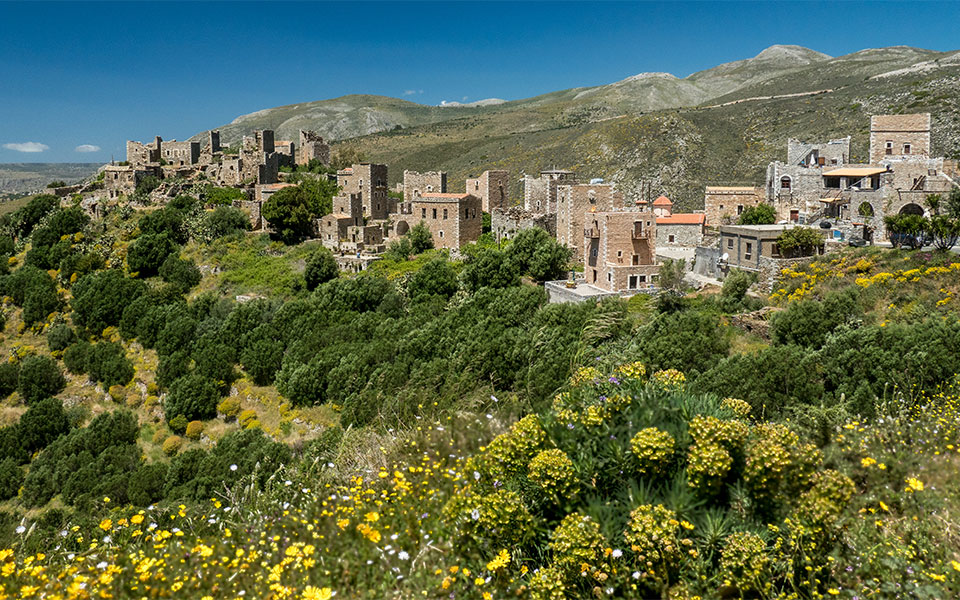
© Getty Images/Ideal Image
What better way to enjoy the beauty of nature than by staying at a farm in one of Greece’s most attractive areas? Over the last few decades in Greece, agritourism has developed in rural areas, providing a sustainable alternative form of tourism that’s a winning proposition for private owners, the communities they live in and the tourists who experience firsthand a different way of life while enjoying the added perks of fresh air, natural surroundings, traditional events, farm-to-table gastronomy and charming amenities.
The Eumelia farm in Gouves has five lavish cottages with bathrooms and mini kitchens that can comfortably house up to four guests each (and their pets, as it welcomes four-legged friends). The farm is set in a lush ancient olive grove with Myrtolia, Koroneiki and Agrelia olive trees, and it produces its own high-quality olive oil. Eumelia offers guests of all ages memorable experiences such as wine and olive oil tastings, educational tours of their biodynamic farm, and workshops and activities ranging from yoga and soap-making to cooking classes and hikes. Guests dine on home-grown organic products and enjoy treats such as starlit dinners and more.
Read more here.

The terroir of Drama lends itself exceptionally to wine making, providing success with the usual grape varieties as well as the recently revived Greek strains.
© Shutterstock
The Rodopi mountain range, the Nestos River in the forest of Elatia, Greece’s only birch forest, and the Frakto virgin forest – one of the planet’s most precious ecosystems – are just some of the reasons why visitors head to Drama in search of unforgettable back-to-nature experiences.
Another draw is the fact that Drama has gained recognition as an outstanding wine-producing area, a place well worth visiting for those adventurers in search of exciting Greek wines. Covering some 500 hectares, the vineyards in the villages of Agios Athanasios, Adrianis, Agora, Doxato, Mikrochori, and Kokkinogeia supply nine different wineries.
Here, you’ll find the ultimate wine-lover’s paradise, where vineyards, wineries, and sophisticated tasting rooms come together to form a rich and diverse oenological landscape. Immerse yourself in unique stories of generations-old wineries and discover the winemaking styles of each of them, from the historic Ktima Klonaridis to the cutting-edge Oinogenesis. With some of Greece’s best and most welcoming wineries here, you’re in for a one-of-a-kind experience.
Wine lovers flock here to try exceptional blends of international grape varieties that include Cabernet Sauvignon, Sauvignon Blanc, and Merlot, all of which thrive in the local terrain. Explore local favorites as well, including Assyrtiko, Malagousia, and Agiorgitiko, and taste the distinct flavors that make Drama a wonderful destination in the world of wine.
Read more about Drama here.
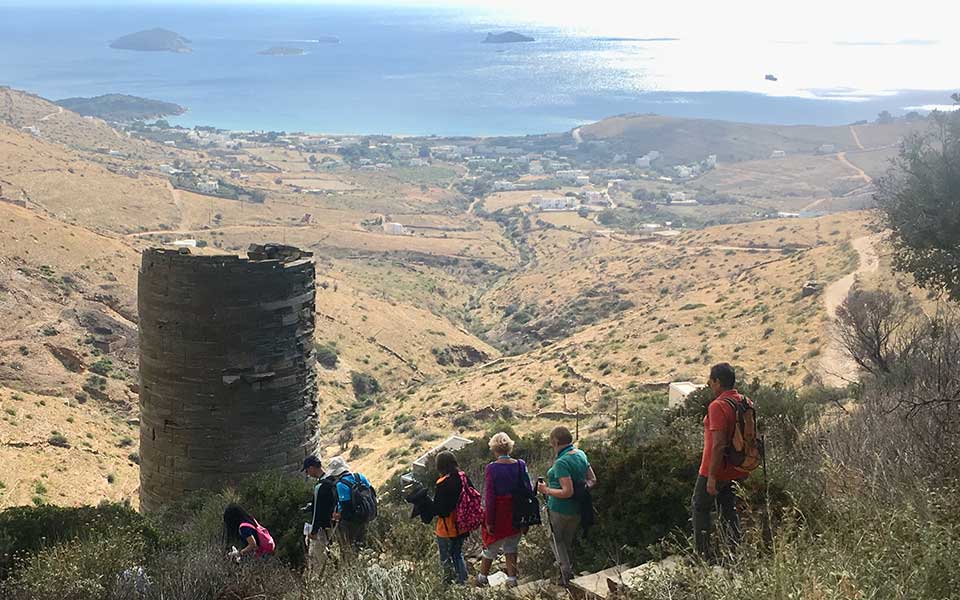
Walking on route 15, north-west Andros, during the 2nd Andros on Foot Festival (2019) at Agios Petros ancient tower (c. 4th-5th century BC).
© Andros Routes
This increasingly popular Cycladic gem, now only an hour by boat (until recently the trip took two hours) from the port of Rafina outside of Athens, has become a top destination for hikers, chiefly thanks to its extensive network of picturesque footpaths. Here, you’ll enjoy the fresh aroma of breezes scented with herbs and flowers, drink cold mountain water gushing from natural springs, take in stunning views of sprawling valleys, villages and the wide Aegean, and explore ancient sites and their ruins.
If you like the sound of that, you’ll love taking part in the jaw-dropping scenic hikes organized by Andros Routes around the island. Trails will take you past castles and elegant old houses, lush open fields dotted with grazing horses and cows, fast-flowing rivers and brooks, stands of fruit trees and, especially in the spring, valleys splendidly carpeted with aromatic flowers of every shade. With Andros Routes, your visit to charming villages such as verdant Menites, traditional Sineti, lively Batsi and quaint Apikia often include an organized visit to a local’s house, where you can chat over lemonade and local sweets and gain a deeper understanding of life on the island.
Alternatively, you can hit the scenic routes of the footpaths (kalderimia) on your own by purchasing a map at the port – the paths have been cleared and well-marked by Andros Routes and their many international volunteers in an ongoing project.
Read more about Andros here.
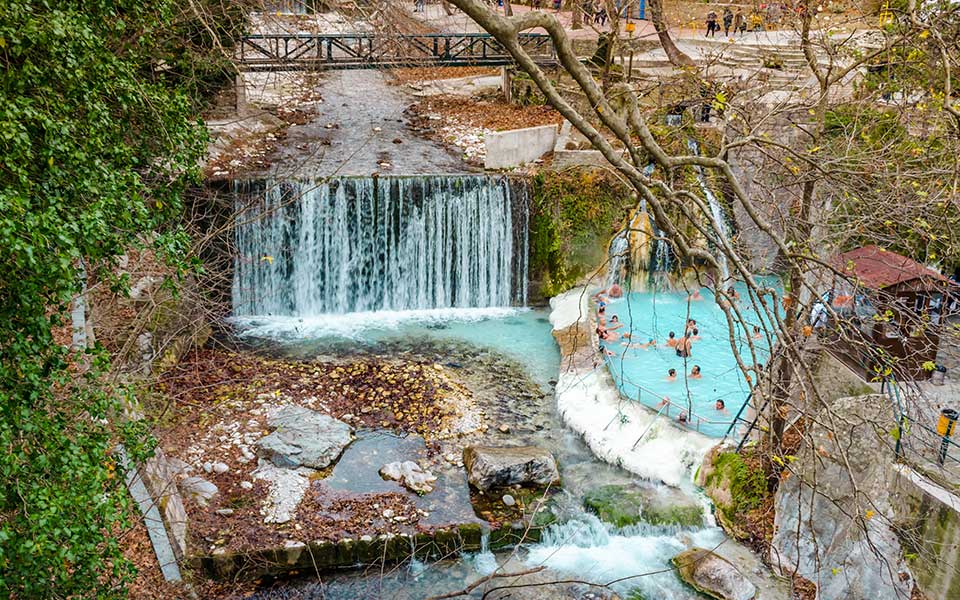
Thermal baths and hot springs in Pozar.
© Shutterstock
The Pozar Thermal Baths, located between Orma and Loutraki, the main tourist hotspots in the area, lie in the valley of the Thermopotamos (or Nikolaos) River, where there are warm water springs with beneficial minerals. Deeply atmospheric in winter, the area surrounding these springs is particularly magnificent during springtime, when the countryside explodes with colors.
In the river there are pools and waterfalls where the curative thermal waters can reach temperatures of 37 degrees Celsius. Minerals in the water include potassium (said to help the cardiovascular and digestive systems to function), sodium (purported to help maintain the balance of bodily fluids), and fluoride (useful in fighting osteoporosis).
Spa therapy here is very popular, and the reputation of the baths goes beyonds the country’s borders. The facilities are quite large; they include both the old hydrotherapy center and the more modern “Alexandrio” center, as well as a large outdoor pool and a few smaller basins that lie along the river’s course. You can combine a soak with a massage at Pozar’s facilities or in nearby Loutraki, where there are several centers offering massage therapy, aromatherapy and lithotherapy (involving hot and cold stones).
Read about our writer’s experience in Pozar here.
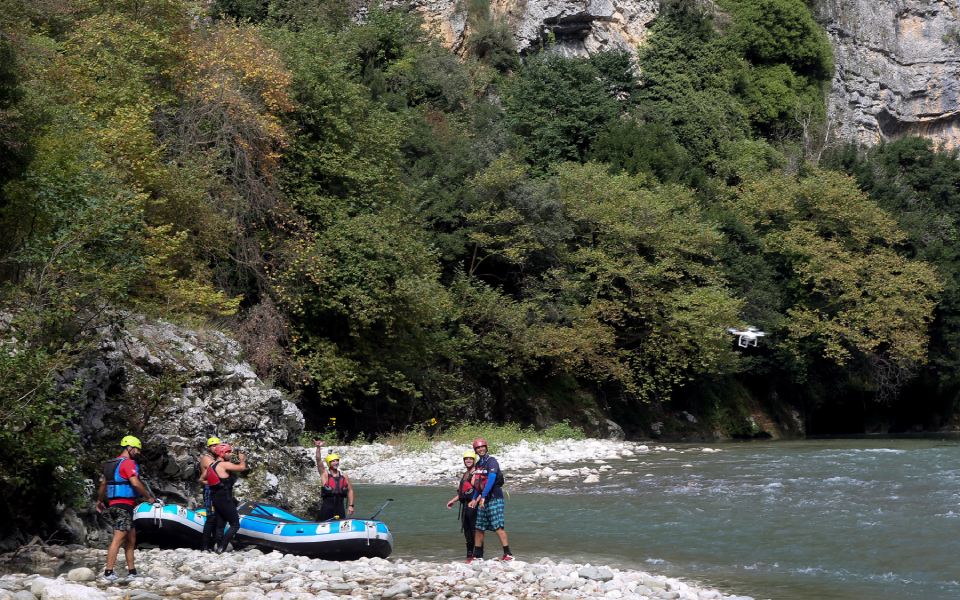
The Arachthos River in Epirus
© Intime News
A unique experience awaits those who take to the waterways in the rich natural environment of Epirus, with its deep gorges and canyons, soaring mountains and wide green forests.
The Arachthos River is one of the most impressive rivers in Greece, and it’s ideal for rafting, combining exciting whitewater stretches with calmer sections. As you ride the current downstream, you’ll pass through the wild, imposing Arachthos Gorge and stop to see the Glafki Waterfall. The river also features two of the most famous stone bridges in Greece, those of Arta and Plaka. Rafting down the Arachthos is an exhilarating way to take in the rare beauty of this part of the country.
Greek Adventure is just one of several organizations that offer Arachthos River rafting experiences to all interested parties nine years old or older. They start their river runs at the Plitsa Bridge in Ampelochori and finish up just beyond Plaka Bridge.
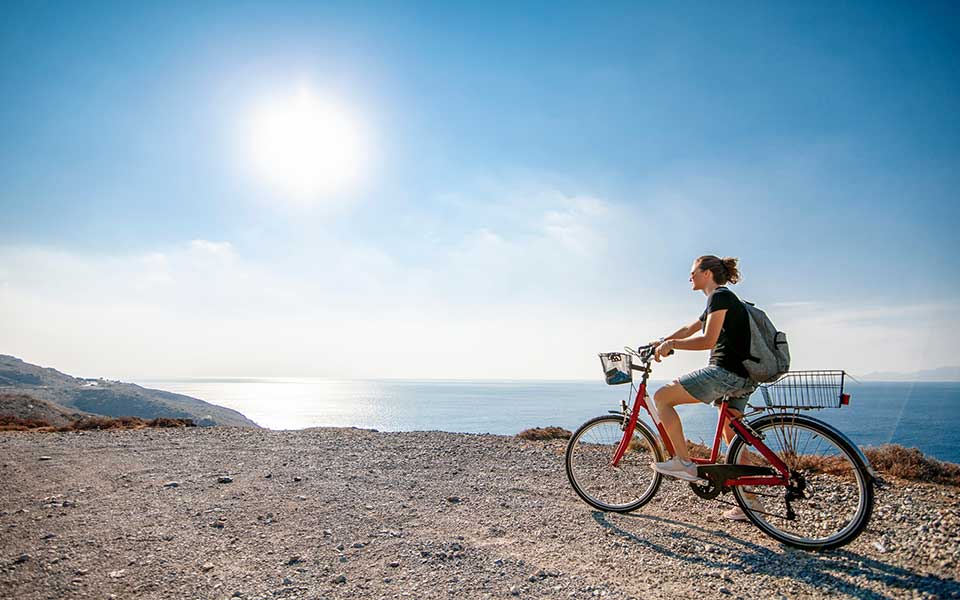
A blissful cycling tour through the unspoilt countryside of Aegina.
© Shutterstock
Aegina is an ideal destination for either an overnight or weekend trip, since it’s both easily accessible –40 minutes from Piraeus – and small enough to cover in a short period of time. It helps, too, that you can move around the island easily by bicycle.
Start your two-wheeled explorations by cycling the route from Aegina Town to the famous fishing village of Perdika; this is where everyone goes to enjoy meals at the fish tavernas lining the waterfront, and to visit the nearby islet of Moni, a haven for peacocks and deer. This is the easiest route on the island: just 9km, it runs along the shore and there’s no significant changes in elevation.
For more experienced cyclists, try the route that starts from Aegina Town and ascends towards the east (follow the signs for Aghia Marina). The incline is relatively gentle until you reach the Monastery of Aghios Nektarios, the famous pilgrimage site of Aegina. Here, you’ll need to take a deep breath if you want to pedal up the steep hill towards Palaiochora, the island’s capital until the 18th century.
Alternatively, you can continue to the Temple of Aphaea and Aghia Marina, or head north, following the secondary asphalt road that crosses the pine forest before descending to Souvala, the second port of the island. Head west along the shore here, passing through Vathi. The most beautiful part of the route begins here: you’ll see the house where the author Nikos Kazantzakis lived for some years, then a lighthouse, a few small ports and some rocky stretches of shore with crystal clear waters before the archeological site of Kolona, just north of Aegina Town, the end of circular route of 20km.
Find out more about Aegina here.
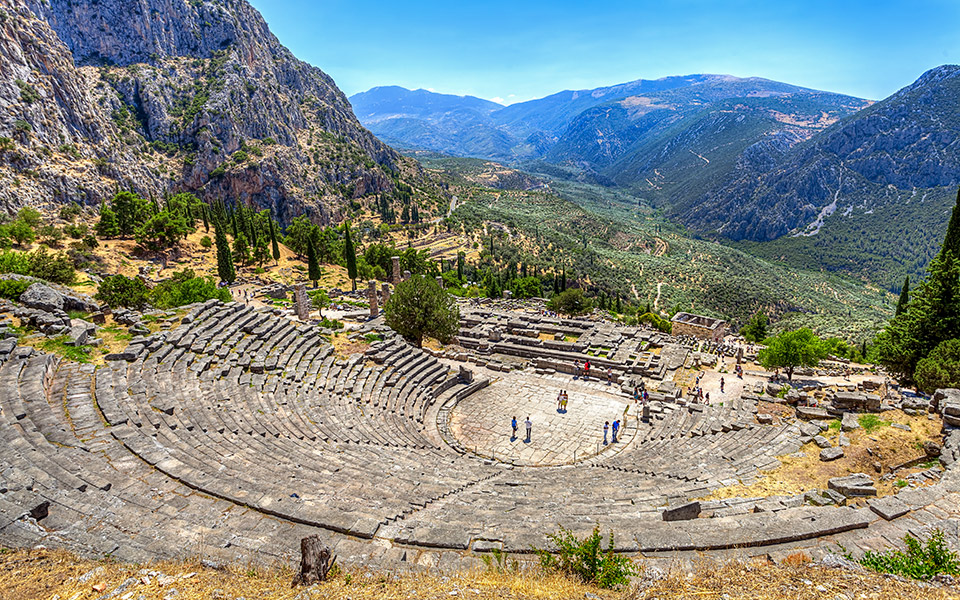
The Ancient Theater of Delphi on the slopes of Mount Parnassos.
© Shutterstock
An estimated 500,000 tourists from around the world visit the UNESCO World Heritage archaeological site of Delphi, one of the most stunning places in the world, every year. In the spring, the mountainside is flecked with crimson, gold, pink, white and lilac wildflowers. At this time of year, the temperature is ideal and the site is not usually too crowded.
Below Delphi, a wide area boasting a million olive trees cascades all the way to the Gulf of Corinth; this is Greece’s largest continuous olive grove, known as “the sea of olives.”
To make sure you don’t miss anything, do like the ancients did and start your visit at the Tholos of Delphi in the Sanctuary of Athena Pronaia, where those who came to petition the Pythia first offered a sacrifice. Next, walk up to the Castallian Fountain, where worshippers of Apollo bathed before entering the site, and drink mineral water at the nearby mountain spring. Then head up into the main site, along the Sacred Way, stopping to admire the site’s most important monument, the Temple of Apollo. Put aside at least three hours to explore the site; the all-day ticket for the site includes a visit to the excellent on-site Archaeological Museum.
While here, it’s also well worth venturing up Mt Parnassos, following flower-filled paths to abandoned mountain shelters, springs and caves, or tracing the ancient trail from Delphi through the quaint village of Hrisso, with its breathtaking views over the verdant olive grove down to the sea in Itea, once the site of an ancient port.
Discover more to do in Delphi here.
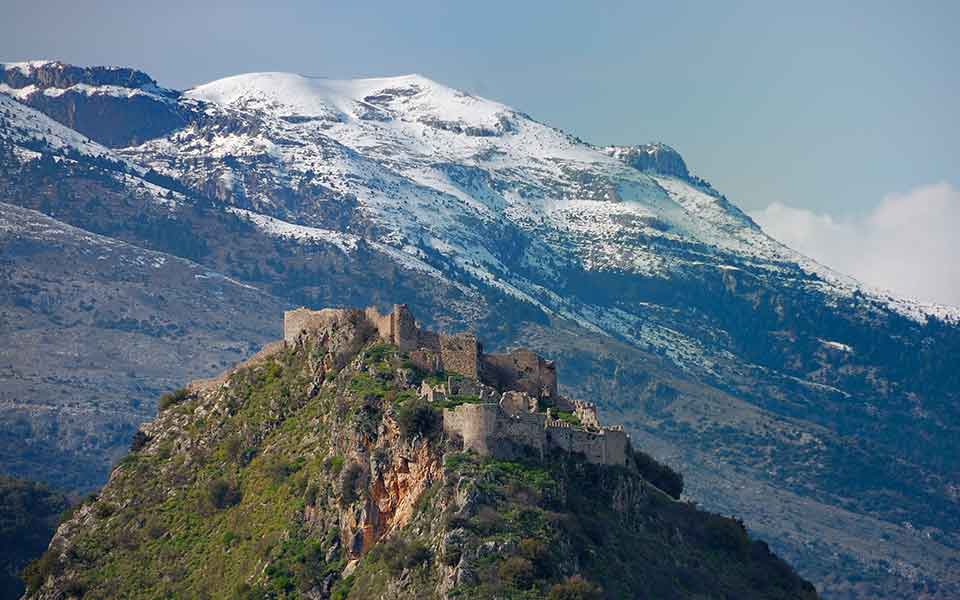
The Frankish castle of Mystras is crowned by Mt Taygetos, which in spring still has snow-capped peaks.
© Shutterstock
Surrounded by lush green forests, the multi-award winning Euphoria Retreat is located in Mystras, in the southeastern Peloponnese, a fortified town built amphitheatrically around a Frankish castle and overshadowed by Mt Taygetos, which, in spring, still has snow-capped peaks.
Not a spa hotel but instead one of Greece’s most sophisticated healing resorts, where guests follow tailored health programs and regimens to rebalance and reboot themselves, Euphoiria runs several retreats and workshops throughout the year. This spring, it will be running the “Spartan Spirit of Adventure” retreat, which involves “celebrating inner resilience in the style of our local warrior ancestors, who were revered for their military prowess.” During this one-week retreat, guests will venture out on five daily excursions, each to a different location, in what is a wonderful opportunity to explore the region’s natural and cultural diversity. Wondering if this is for you? It is if you can endure two to three hours of intense exercise daily, including activities such as running, cycling, rock climbing and hiking.
The really good news is that you’ll get to recover in the retreat’s spectacular four-story spa, with its unique swimming pool and full catalog of progressive pampering therapies, and to refuel with organic, nutritious food made on-site at Euphoria’s stylish restaurant.
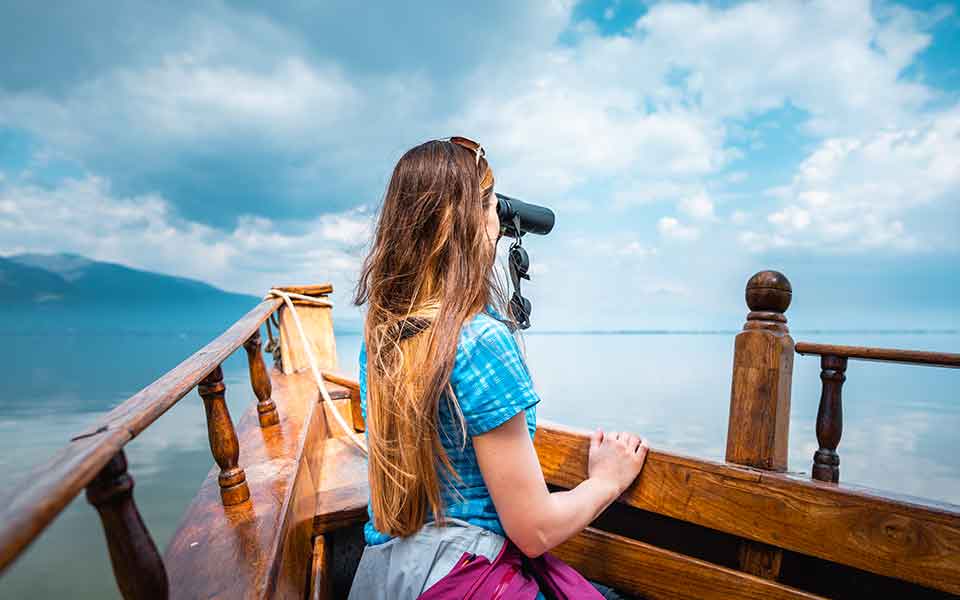
Home to some of Europe’s most spectacular wetlands, Greece is a birdwatchers paradise.
© Shutterstock
Just west of Thessaloniki, right where the city’s industrial zone ends, is a world of astounding natural beauty. This is the Axios Delta National Park, where you can see many different bird species and enjoy views over the delta of the Aliakmon River and out to the Thermaic Gulf.
Thousands of ducks from several different species, along with pelicans, herons and birds of prey are among the many feathered creatures that frequent these wetlands. With luck, you might even spot a white-tailed sea eagle; one of the few pairs left in Greece nests here. You can also walk or cycle on paths through the wetlands – bikes are available.
Continuing south along a road that’s flanked by vineyards and forested ravines on the one side and the sea on the other will bring you to one of Greece’s most important wetlands – the Alyki Kitrous Lagoon, home to many wading birds.
A trail leads from the village of Kalochori towards the sea, and dirt roads crisscross the landscape as far as your legs will take you. Walk along the shore for views of Thessaloniki on the one side and of tranquil wetland ponds, home to plovers, avocets, black-winged stilts and other leggy wading birds, on the other.
Read more about the Axios Delta here.
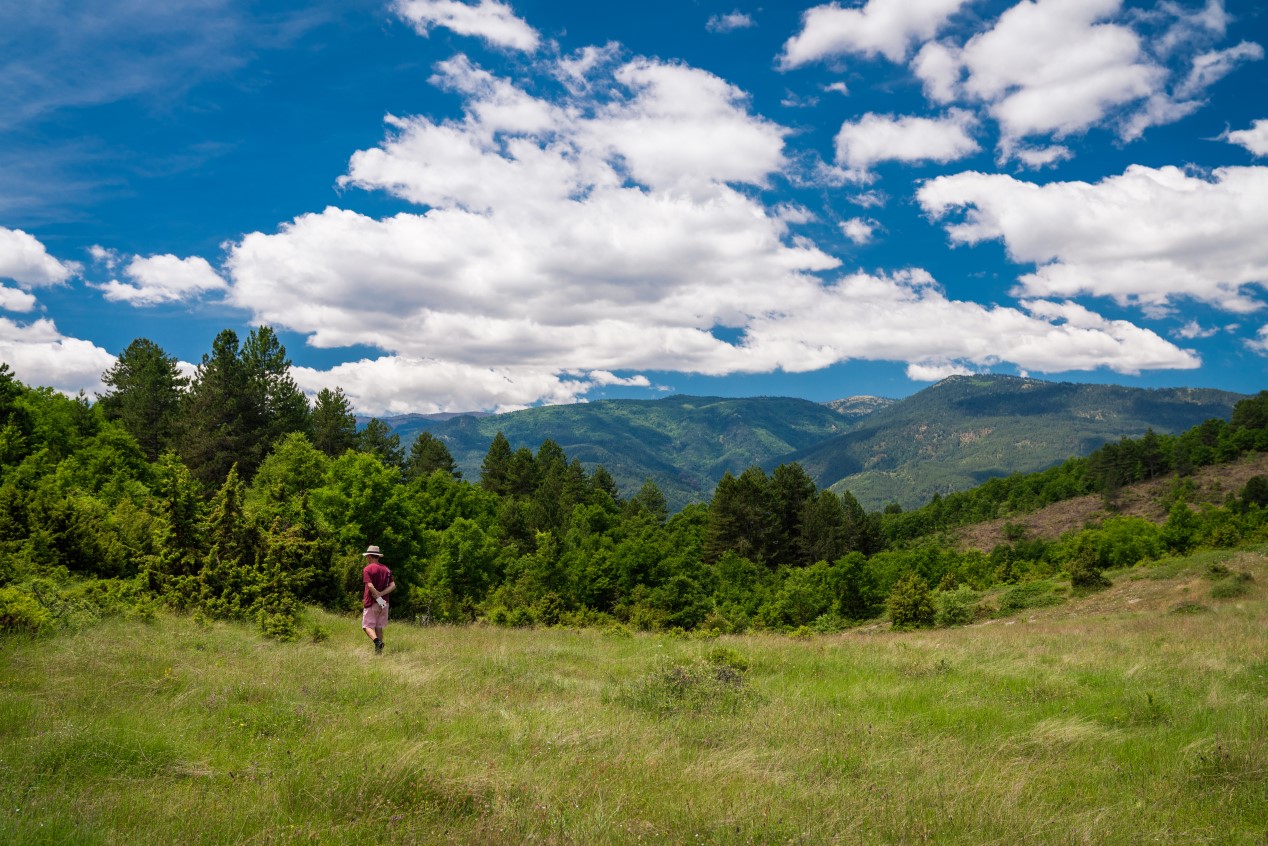
The Valia Calda valley
© Nicholas Mastoras
One of the most beloved hiking routes in Greece begins at Aoos Springs Lake, traverses Valia Calda and ends in Vovousa. It is a long trail, with many changes in landscape to admire, and in this direction it has many downhill sections as well as stretches of level ground.
The route begins as a path through a forested area, and then continues as a dirt road. Beyond the Mavrovouni refuge, as you head towards the summit of Flega Peak, you’ll enter an alpine zone. On a clear day, you can see the lake below and the surrounding peaks. A bit further along, you’ll come to the two Flega lakes, home to alpine tritons (newts), while the way down to Valia Calda is dotted with robola pines, a number of which have been struck by lightning.
From this point you navigate through thick vegetation at the heart of the Valia Calda National Park. Here, the sunlight does not penetrate the foliage; there are many streams here, and the sound of running water fills the air. The tall beech trees and a mulchy chill will accompany you for the next two to three hours, until you come across the Arkoudorema, a tributary of the Aoos River. Walk parallel to the water along an easy route until Smixomata, where Arkoudorema meets the Aoos. From here, following the course of the river will take you to the Vovousa refuge.
Pacing is important on this long hike; take your first breather on Flega Peak, admire the view and regain your strength. Stop for a snack on the banks of the larger of the Flega lakes; the spring water that fills this lake feeds the second lake further down as well. Turn left towards Vovousa as soon as you come across the Arkoudorema, and a few meters down you’ll find a plateau by the water, an ideal resting place. You can catch your breath one last time at the spot where the Arkoudorema meets the Aoos River.
Read more about exploring the Valia Calda here.
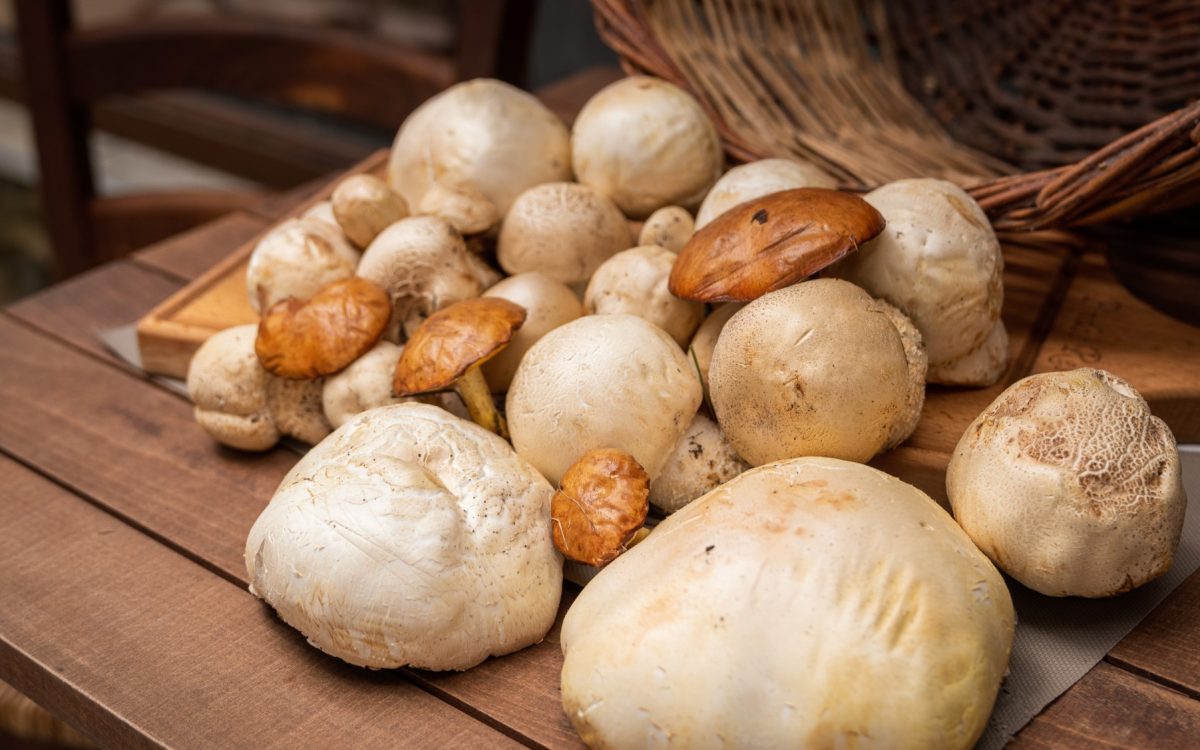
Mushroom hunting and eating
© Nicholas Mastoras
One of the most delightful ways to experience springtime in Greece is by combining walking in nature with foraging for food… that you can then eat, after it’s been prepared for you by a chef. One such tour takes place in Arcadia and is organized by Fungi Hellas. Located in the center of the Peloponnese, the region of Arcadia is best known for its pristine natural environment, which is especially spectacular in springtime, and for its many religious, cultural and historical landmarks.
In this natural wonderland, Fungi Hellas invites participants on a rousing forest adventure with experienced mushroom collectors, where you’ll spend two to three hours hiking through verdant wilderness. As you forage, you’ll be taught to distinguish between different mushroom types and discover their uses. Don’t worry about fitness levels; this hike is suitable for everyone from aged five to 80+. The route can also be customized to create shorter walks, tailored to the physical abilities of the group that books it.
As part of the experience, you’ll enjoy a picnic in a striking natural setting by a river or a waterfall, or in some other picturesque location. Together, you’ll examine the mushrooms (and truffles) you’ve collected and learn more about their unique qualities. As you relax and savor the beauty of your surroundings, the Fungi Hellas chef will whip up some mushroom dishes to be accompanied by local wine and other products.
Read more about mushroom foraging in Greece here.
A steep and curvy drive high...
A summer mix of cultural events...
When the summer crowds depart, Greece’s...
A soulful celebration of longevity, blending...